What Letters Should Children Learn First
Welcome to Part one of Teaching the Alphabet! I receive several emails a week, asking for advice on how to teach letters and/or letter sounds to children from Pre-K through 1st grades.
So, today I'm going to share a few ideas for education kids in this age-range. If y'all have a younger child (toddler age), I share more tips about instruction toddlers the alphabet in this post.
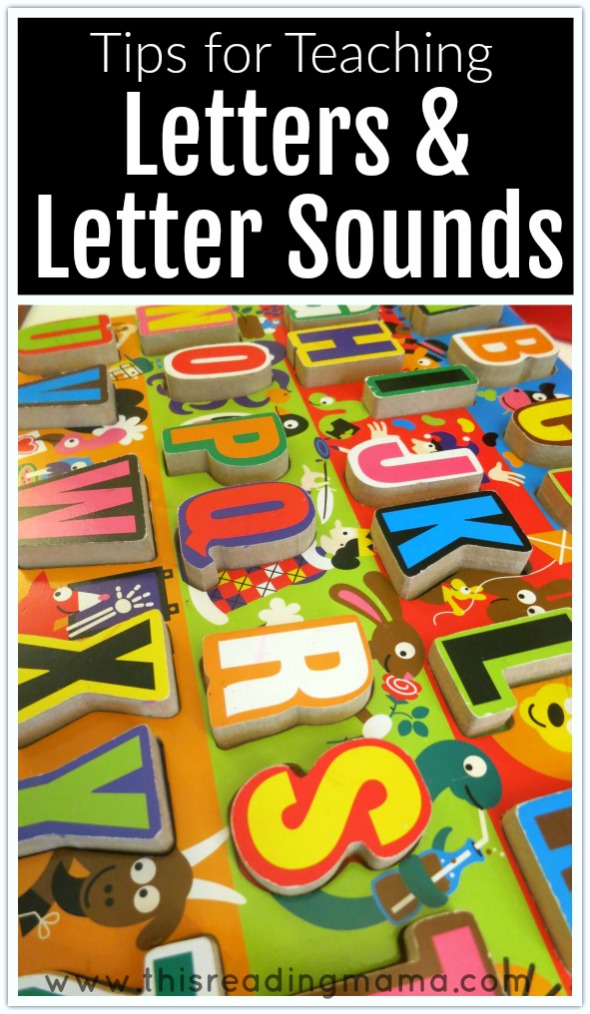
Note that I'thou going to explore some hot topics in regards to letters and letter sounds. You lot may completely agree or disagree with my pedagogy tips. Ultimately, yous have to observe what works best for your child and stick with it.
*This mail service contains affiliate links.
Messages OR Letter Sounds?
So which is it? Should we teach letters or letter sounds? There is a widely-used teaching arroyo which teaches letter of the alphabet sounds offset and alphabetic character names next. It is believed that letter sounds are more than helpful and useful to pre-readers than letter of the alphabet names and therefore, should exist taught first. As you've probably guessed from the championship of my post, I respectfully disagree. And before I go too much further, please hear me say this: if teaching your child her letter sounds showtime is working, GO FOR It!
I believe, later reading the reading research out there (such as Ehri, Invernizzi, Cunningham, Calkins, and McBride-Chang), that BOTH letters and alphabetic character sounds are highly useful for teaching kids to read and write.
Just iii of many reasons I believe this (I would probably bore you with all my reasons):
i-The majority of letter of the alphabet names requite the child a huge inkling as to the audio (or i of the sounds) they make. For example, the letter D has the /d/ audio at the showtime and the letter F has the /f/ sound at the end.Due west, Y, and H are the only three exceptions.
2- Alphabetic character names make great labels for letters, as many of the letter sounds are harder to make in isolation. For example, b's sound in isolation tends to sound more than like /buh/, which can make blending it with other letter of the alphabet sounds difficult for beginning readers.
3- Letter sounds are more abstract and aren't as consistent as letter names. Take for example the A in Target. In my experience, it seems more than consistent to say, "Oh, I come across the letter A in Target," than "I see an /a/ (brusque a audio) in Target…but it doesn't make the /a/ sound. Information technology makes the /r/ sound." Huh?
No matter what you believe in regards to letters and letter names, "enquiry has established that children who know the names of messages learn letter of the alphabet-sound associations more readily than those without alphabetic character-proper name knowledge." (Words their Style for PreK-M, 2014)
Upper or Lower Case Letters?
Once more, you lot're going to hear me say BOTH! Kids need both upper and lowercase letter educational activity. While lower instance letters are more common in reading and writing, both are needed. If you're education immature children, I suggest starting with uppercase letters. Why?
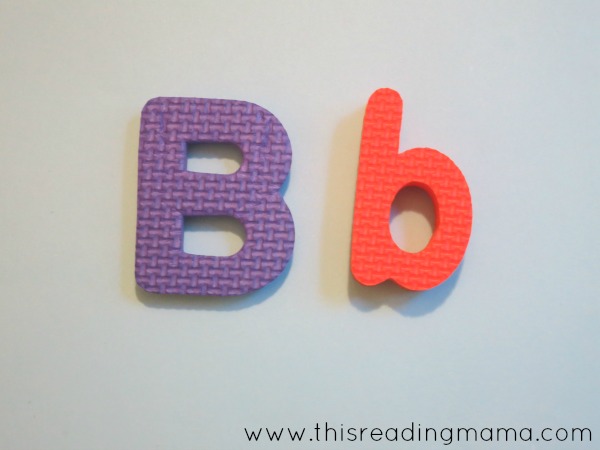
Two reasons:
1- Uppercase messages are easier to visually distinguish than lowercase letters (accept for example- the uppercase B and D versus the lowercase b and d)
ii- Uppercase messages are easier for first writers (for instance, Eastward versus e). Even when instructed with lower case letters, I've noticed over and over again that young children naturally prefer upper-case letter.
Simply please hear me say that while I may starting time education with majuscule letters when working with young children, I believe it'southward important to expose young children to all kinds of letters, even different kinds of fonts. Pointing out and talking nearly the kinds of letters you discover while reading together, as well known equally print awareness, is a Peachy way to integrate this into what you're already doing (both for younger and older children).
Letter Confusion
While some may teach letters in alphabetical order, I believe there is a more developmentally appropriate manner than starting with a and ending with z. I like to introduce letters and alphabetic character sounds in a different order, which tin help to minimize confusion.
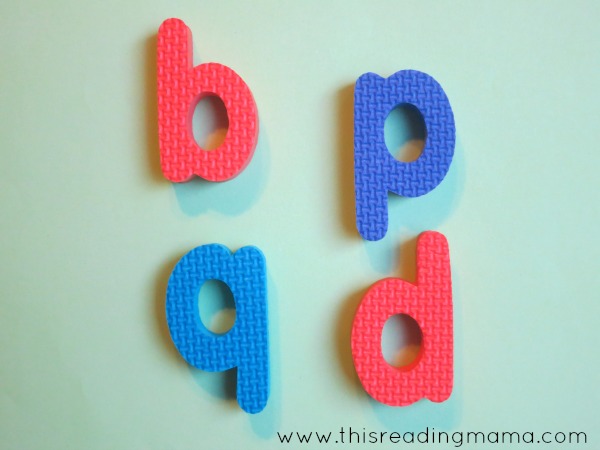
Visual Similarities
Some letters look very much the same (such equally b, d, p, and q or W, V, Y). And kids confuse these oft, fifty-fifty older kids. I encourage y'all to separate these letters and teach them at unlike times to minimize confusion.
The Point of Articulation
While this may sound fancy, it'south just a fashion of saying that some letters, while they look very different, take sounds that are produced in the aforementioned part of the mouth. Have for example m and k. Both sounds are guttural (produced in the back of the throat). If you lot say a /g/ sound without using your voice, you become the /k/ sound. Other letter sounds to avoid teaching together are t and d, f and v, or b and p.
Speech Delays
Some kids (I have ii of my own) have difficulty with the product of sure letter sounds. These letters may include f, j, l, r, s, 5, y, or z. While I am not an expert in this field, I do know that speech delays can filibuster letter audio learning, spelling, and reading. 2 of my favorite resources for helping kids with articulation bug has been Katie of Playing with Words 365 and Reading with TLC's Lively Messages.
Letter of the Calendar week?
Letter of the Week has gotten a bad rap. I've even advocated against it at times. My thoughts are still mixed on the topic. And I'll share why.
- Letter of the Week can exist an effective manner to brand certain your phonics instruction is meaningful, playful, and systematic. Many kids demand systematic phonics instruction, especially kids who are struggling to grasp their letters and sounds, BUT…

- Letter of the alphabet of the Week should not limit your phonics educational activity to only that letter, specially as your child develops into the late Preschool and Kindergarten years. If we only focus on one letter a calendar week, information technology takes 26 weeks to become through them all…much besides long of a time for kids to have the ability to take letters and use them for meaningful spelling, reading, and writing. Kids need to have purposeful exposure to messages (all of them) each mean solar day. Letters demand to be pointed out and used during reading time, when you're playing with letter blocks, when yous're writing their name on their art. Messages (all letters) are important, not merely the letter of the calendar week.
- If yous demand something systematic in the Pre-K and Thousand years, I propose starting with two to three letters a week. Choice messages that are visually and phonetically different, equally we've discussed in a higher place, likeT and F. Sort them by their sounds. Sort toys that begin with those sounds. Nosotros can get through the letters at a much faster pace (if the child is ready) if we focus on more one letter a week.
- Sometimes kids already know a handful of messages and their sounds. If you lot think this is the case for your child, there'due south no need to spend an entire week on letters they already know. To find out what your child knows/doesn't know, pull out an abc puzzle and assess her, like I show in this post {complimentary printable cess chart included}. In one case you lot have a grasp on what your child does or does not know, you have a clearer vision on which letters to teach.
Letter Order
In what order should nosotros teach letters? The showtime identify I always start is with the child'south proper noun. A child'south name carries neat meaning to them and a sense of identity. Later on that, I teach letters OUT OF ORDER. The gild in which I teach them depends on the historic period of the child. Most kids can sing the ABC song by the historic period of 2 or 3. They already know the order. Past teaching the letters out of order, yous are ensuring that kids know them out of the context of that vocal. When asking kids, "What'southward this letter of the alphabet?", we want children who do not need to sing the ABC Song to figure it out (I've seen lots of kids do this, even in Kindergarten).
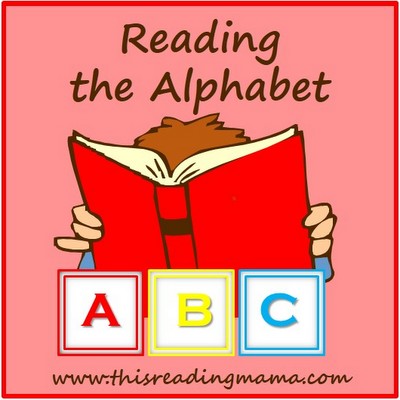
With Reading the Alphabet, I decided to option messages that were visually and phonetically unlike, but were likewise easier to write first. I also chose to add together vowel instruction in early so that kids could brainstorm to form words with the letters, like you lot run into in Lesson vii (AT Family). While each week features one letter, you will run across that we studied more that letter every week, sometimes sorting multiple letters and sounds at one time. But, no matter the gild y'all cull, you want to choose letter combinations for teaching that will minimize confusion.
More Resource on Didactics Letters and Their Sounds:
- Words Their Manner: Letter and Pic Sorts for Emergent Spellers
- Words Their Way for PreK and Thousand (Johnston, et. al)
- Reading the Alphabet – FREE curriculum (taking it a step deeper after kids know their ABC'due south)
- Letter of the alphabet Club Teaching {Living Montessori At present}
- Pedagogy the Alphabet to Preschoolers {The Measured Mom}
- Letting Go of the Letter of the Week {Pre-K Pages}
- Education the Alphabet {PreKinders}
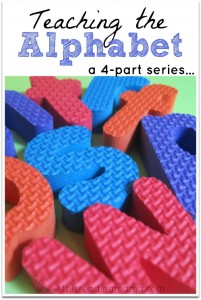
You tin discover all the post in this 4-part series by clickinghither or on the image in a higher place.
~Becky
Source: https://thisreadingmama.com/teaching-letter-sounds/
Posted by: hartmanfesion.blogspot.com

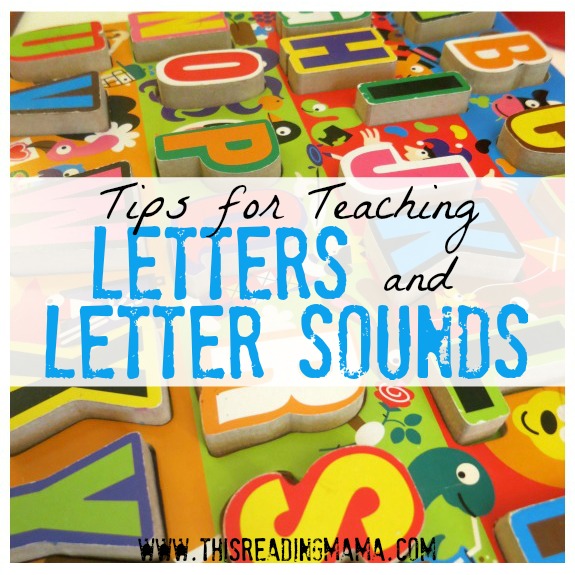

0 Response to "What Letters Should Children Learn First"
Post a Comment